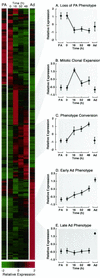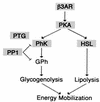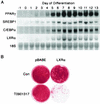Microarray analyses during adipogenesis: understanding the effects of Wnt signaling on adipogenesis and the roles of liver X receptor alpha in adipocyte metabolism
- PMID: 12138207
- PMCID: PMC133961
- DOI: 10.1128/MCB.22.16.5989-5999.2002
Microarray analyses during adipogenesis: understanding the effects of Wnt signaling on adipogenesis and the roles of liver X receptor alpha in adipocyte metabolism
Abstract
Wnt signaling maintains preadipocytes in an undifferentiated state. When Wnt signaling is enforced, 3T3-L1 preadipocytes no longer undergo adipocyte conversion in response to adipogenic medium. Here we used microarray analyses to identify subsets of genes whose expression is aberrant when differentiation is blocked through enforced Wnt signaling. Furthermore, we used the microarray data to identify potentially important adipocyte genes and chose one of these, the liver X receptor alpha (LXR alpha), for further analyses. Our studies indicate that enforced Wnt signaling blunts the changes in gene expression that correspond to mitotic clonal expansion, suggesting that Wnt signaling inhibits adipogenesis in part through dysregulation of the cell cycle. Experiments designed to uncover the potential role of LXR alpha in adipogenesis revealed that this transcription factor, unlike CCAAT/enhancer binding protein alpha and peroxisome proliferator-activated receptor gamma, is not adipogenic but rather inhibits adipogenesis if inappropriately expressed and activated. However, LXR alpha has several important roles in adipocyte function. Our studies show that this nuclear receptor increases basal glucose uptake and glycogen synthesis in 3T3-L1 adipocytes. In addition, LXR alpha increases cholesterol synthesis and release of nonesterified fatty acids. Finally, treatment of mice with an LXR alpha agonist results in increased serum levels of glycerol and nonesterified fatty acids, consistent with increased lipolysis within adipose tissue. These findings demonstrate new metabolic roles for LXR alpha and increase our understanding of adipogenesis.
Figures









Similar articles
-
Cross-talk between peroxisome proliferator-activated receptor (PPAR) alpha and liver X receptor (LXR) in nutritional regulation of fatty acid metabolism. II. LXRs suppress lipid degradation gene promoters through inhibition of PPAR signaling.Mol Endocrinol. 2003 Jul;17(7):1255-67. doi: 10.1210/me.2002-0191. Epub 2003 May 1. Mol Endocrinol. 2003. PMID: 12730332
-
Activated liver X receptors stimulate adipocyte differentiation through induction of peroxisome proliferator-activated receptor gamma expression.Mol Cell Biol. 2004 Apr;24(8):3430-44. doi: 10.1128/MCB.24.8.3430-3444.2004. Mol Cell Biol. 2004. PMID: 15060163 Free PMC article.
-
On the role of liver X receptors in lipid accumulation in adipocytes.Mol Endocrinol. 2003 Feb;17(2):172-82. doi: 10.1210/me.2001-0210. Mol Endocrinol. 2003. PMID: 12554745
-
Chromatin remodeling and epigenetic regulation of the CrabpI gene in adipocyte differentiation.Biochim Biophys Acta. 2012 Jan;1821(1):206-12. doi: 10.1016/j.bbalip.2011.03.003. Epub 2011 Mar 22. Biochim Biophys Acta. 2012. PMID: 21435396 Free PMC article. Review.
-
Roles of lipid-activated receptors in the adipogenic action of fatty acids.Lipids. 1999;34 Suppl:S205-8. doi: 10.1007/BF02562291. Lipids. 1999. PMID: 10419151 Review. No abstract available.
Cited by
-
Catalpol Promotes the Proliferation and Differentiation of Osteoblasts Induced by High Glucose by Inhibiting KDM7A.Diabetes Metab Syndr Obes. 2020 Mar 13;13:705-712. doi: 10.2147/DMSO.S246433. eCollection 2020. Diabetes Metab Syndr Obes. 2020. PMID: 32214833 Free PMC article.
-
Mapping the transcriptional landscape of human white and brown adipogenesis using single-nuclei RNA-seq.Mol Metab. 2023 Aug;74:101746. doi: 10.1016/j.molmet.2023.101746. Epub 2023 Jun 5. Mol Metab. 2023. PMID: 37286033 Free PMC article.
-
The transcription factor paired-related homeobox 1 (Prrx1) inhibits adipogenesis by activating transforming growth factor-β (TGFβ) signaling.J Biol Chem. 2013 Feb 1;288(5):3036-47. doi: 10.1074/jbc.M112.440370. Epub 2012 Dec 17. J Biol Chem. 2013. PMID: 23250756 Free PMC article.
-
Regulation of alternative splicing in obesity and weight loss.Adipocyte. 2013 Jul 1;2(3):143-7. doi: 10.4161/adip.24751. Epub 2013 Apr 22. Adipocyte. 2013. PMID: 23991360 Free PMC article.
-
Genome-wide profiling of PPARgamma:RXR and RNA polymerase II occupancy reveals temporal activation of distinct metabolic pathways and changes in RXR dimer composition during adipogenesis.Genes Dev. 2008 Nov 1;22(21):2953-67. doi: 10.1101/gad.501108. Genes Dev. 2008. PMID: 18981474 Free PMC article.
References
-
- Baumann, C. A., M. J. Brady, and A. R. Saltiel. 2001. Activation of glycogen synthase by insulin in 3T3-L1 adipocytes involves c-Cbl-associating protein (CAP)-dependent and CAP-independent signaling pathways. J. Biol. Chem. 276:6065-6068. - PubMed
-
- Berg, A. H., T. P. Combs, X. Du, M. Brownlee, and P. E. Scherer. 2001. The adipocyte-secreted protein Acrp30 enhances hepatic insulin action. Nat. Med. 7:947-953. - PubMed
-
- Brown, M. S., and J. L. Goldstein. 1998. Sterol regulatory element binding proteins (SREBPs): controllers of lipid synthesis and cellular uptake. Nutr. Rev. 56:S1-S3. - PubMed
-
- Cadigan, K. M., and R. Nusse. 1997. Wnt signaling: a common theme in animal development. Genes Dev. 11:3286-3305. - PubMed
-
- Chawla, A., W. A. Boisvert, C. H. Lee, B. A. Laffitte, Y. Barak, S. B. Joseph, D. Liao, L. Nagy, P. A. Edwards, L. K. Curtiss, R. M. Evans, and P. Tontonoz. 2001. A PPAR gamma-LXR-ABCA1 pathway in macrophages is involved in cholesterol efflux and atherogenesis. Mol. Cell 7:161-171. - PubMed
Publication types
MeSH terms
Substances
Grants and funding
LinkOut - more resources
Full Text Sources
Other Literature Sources
